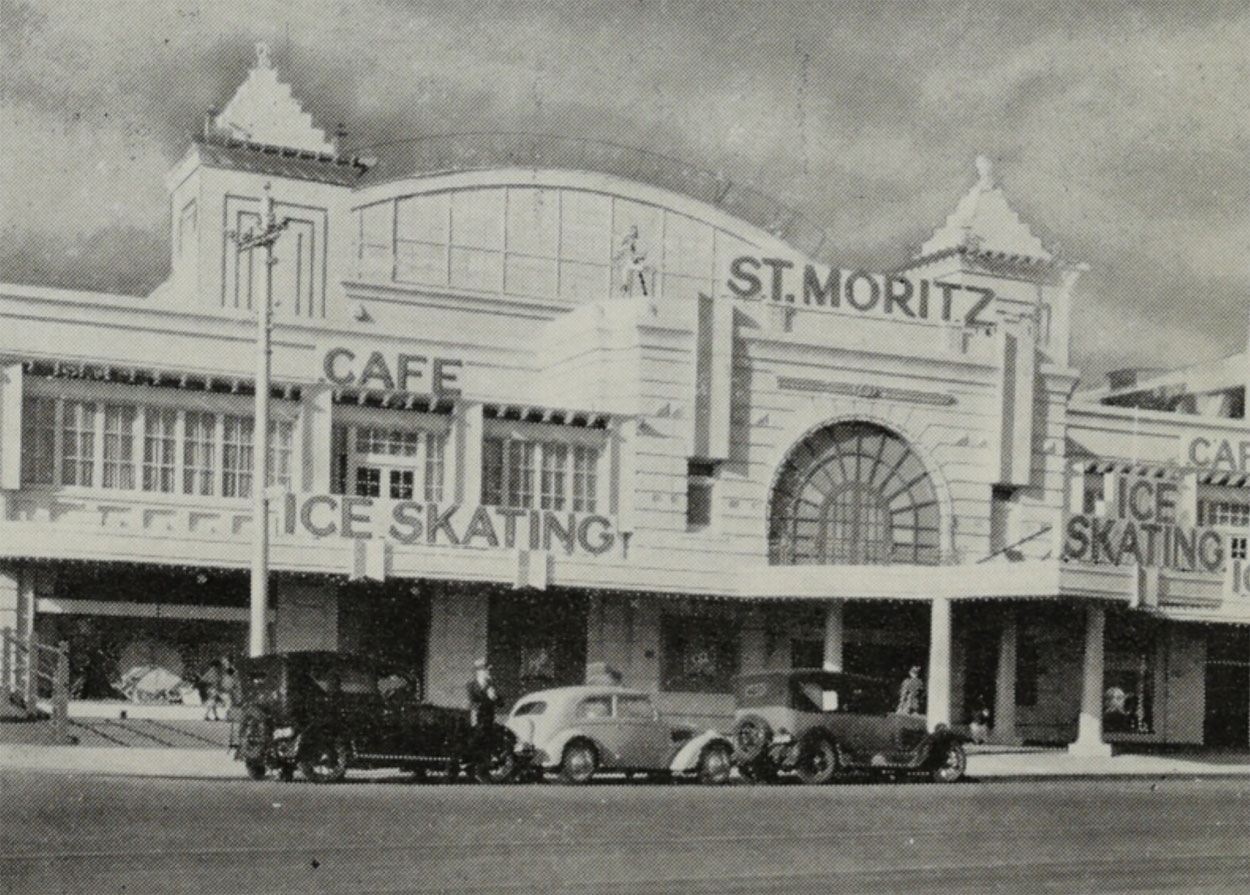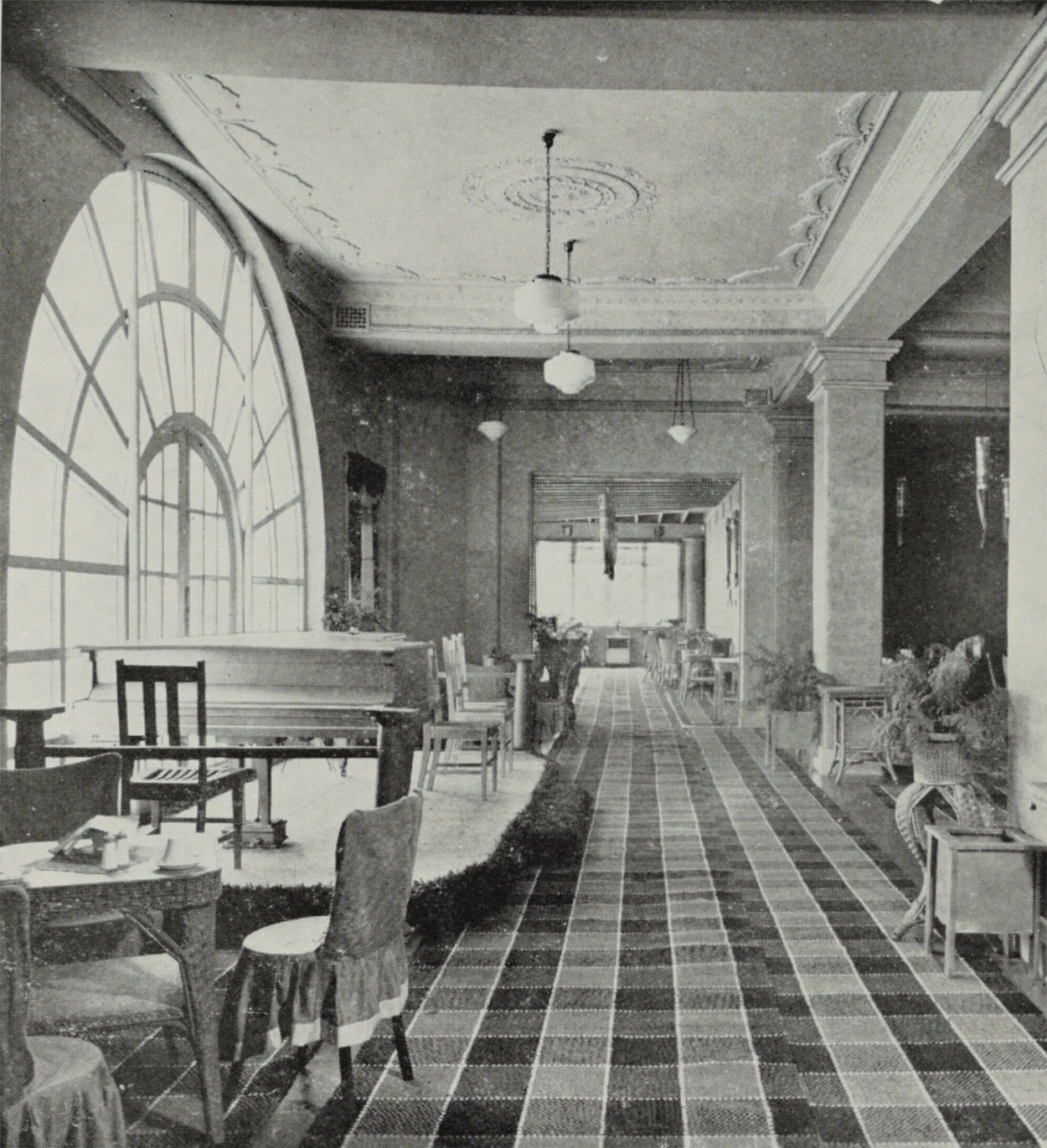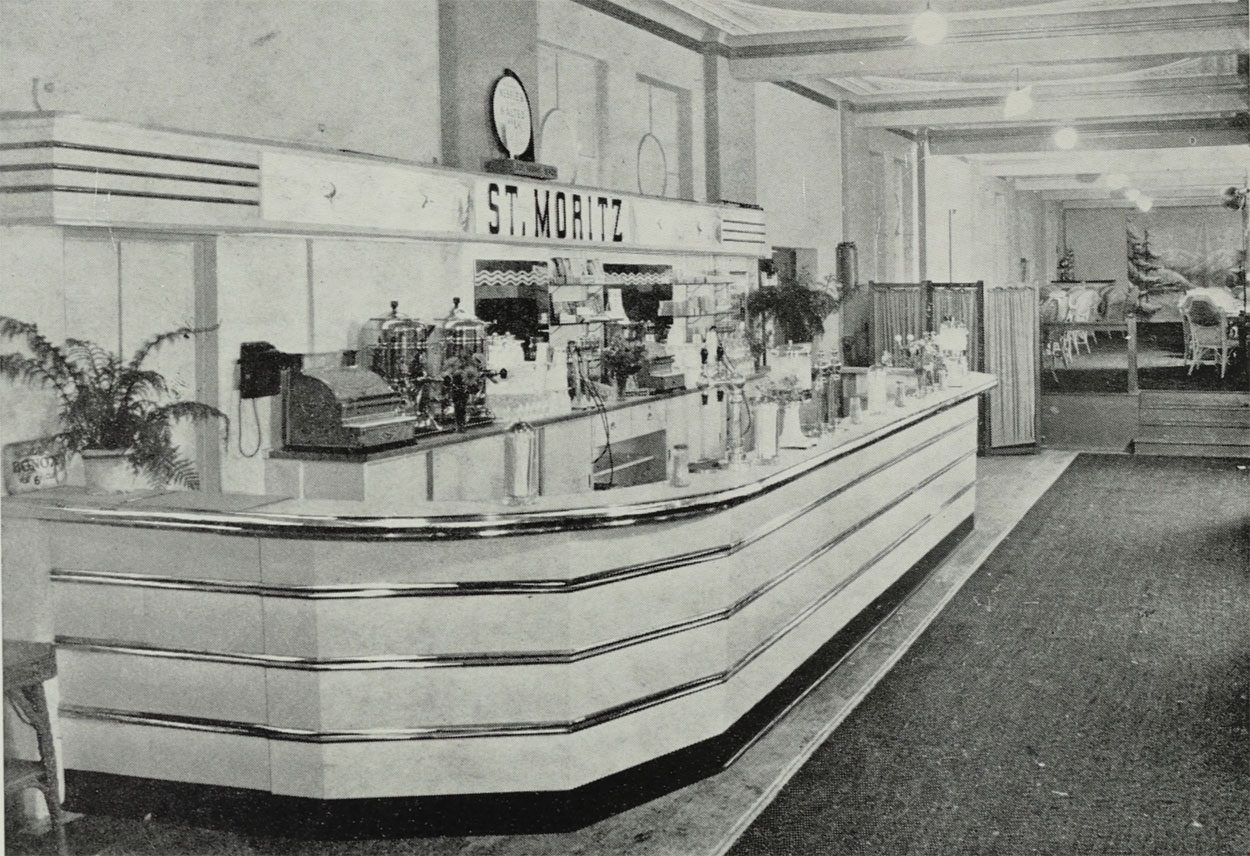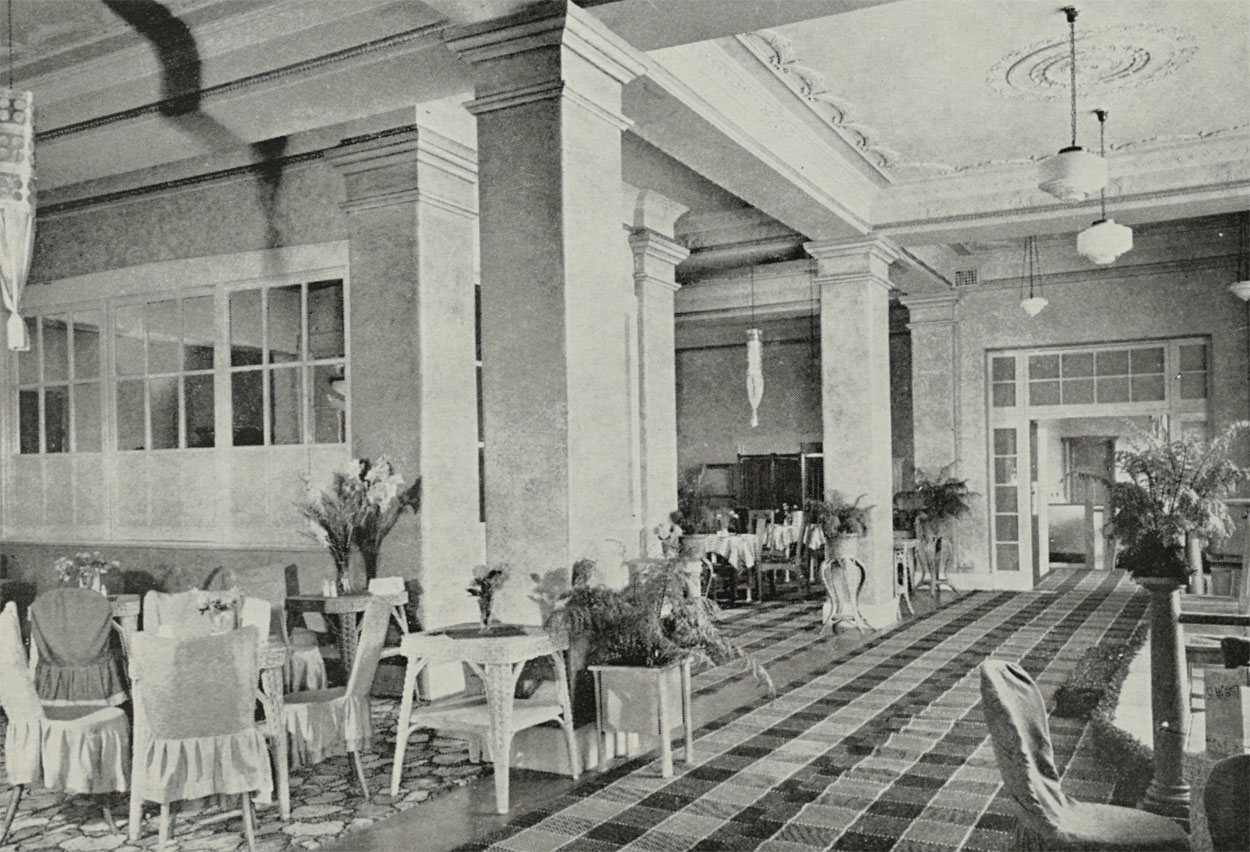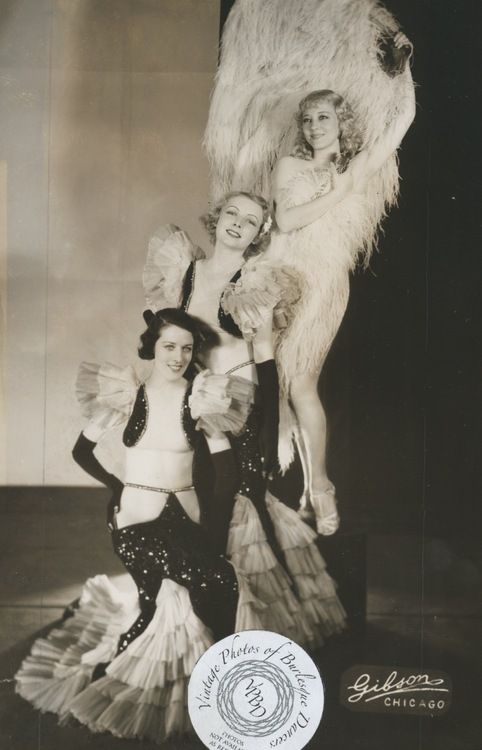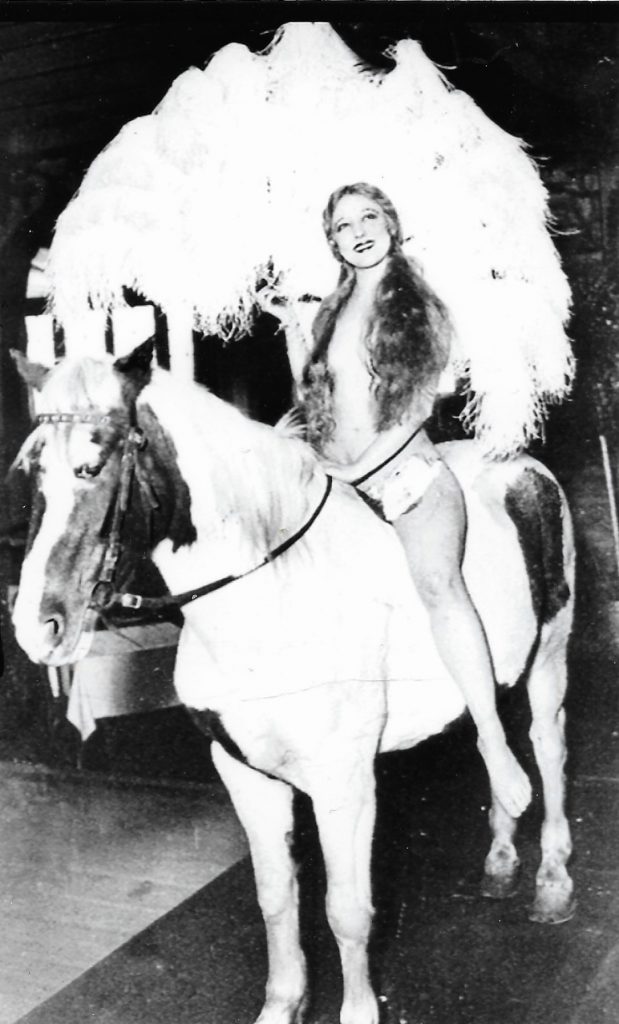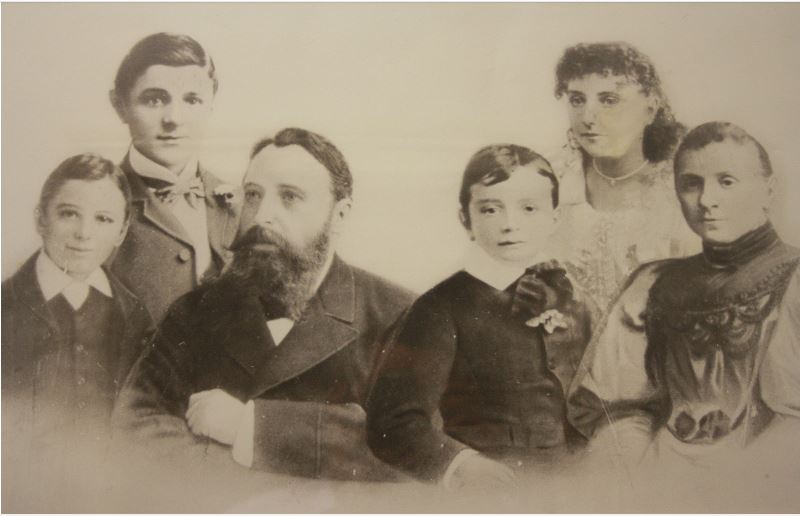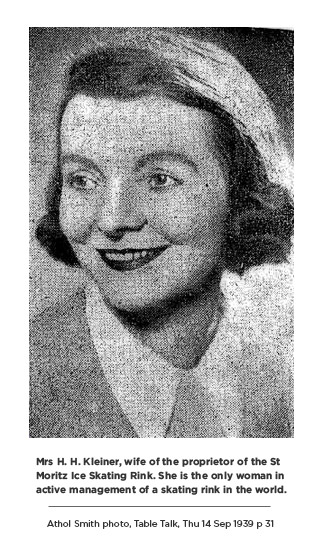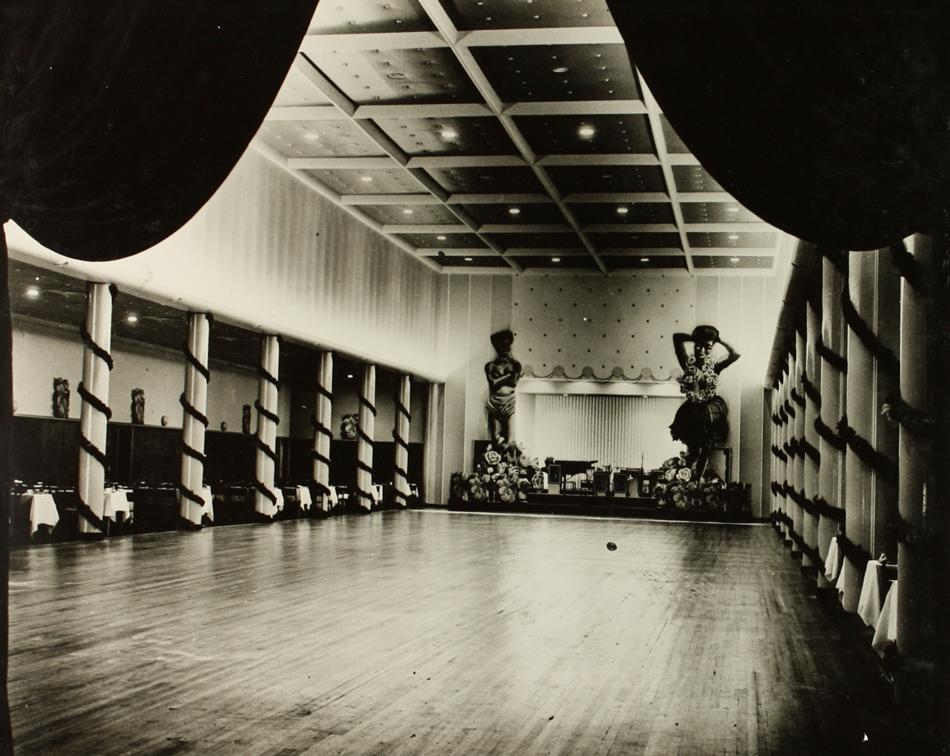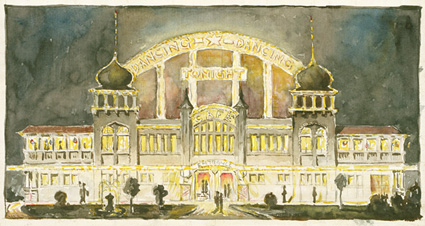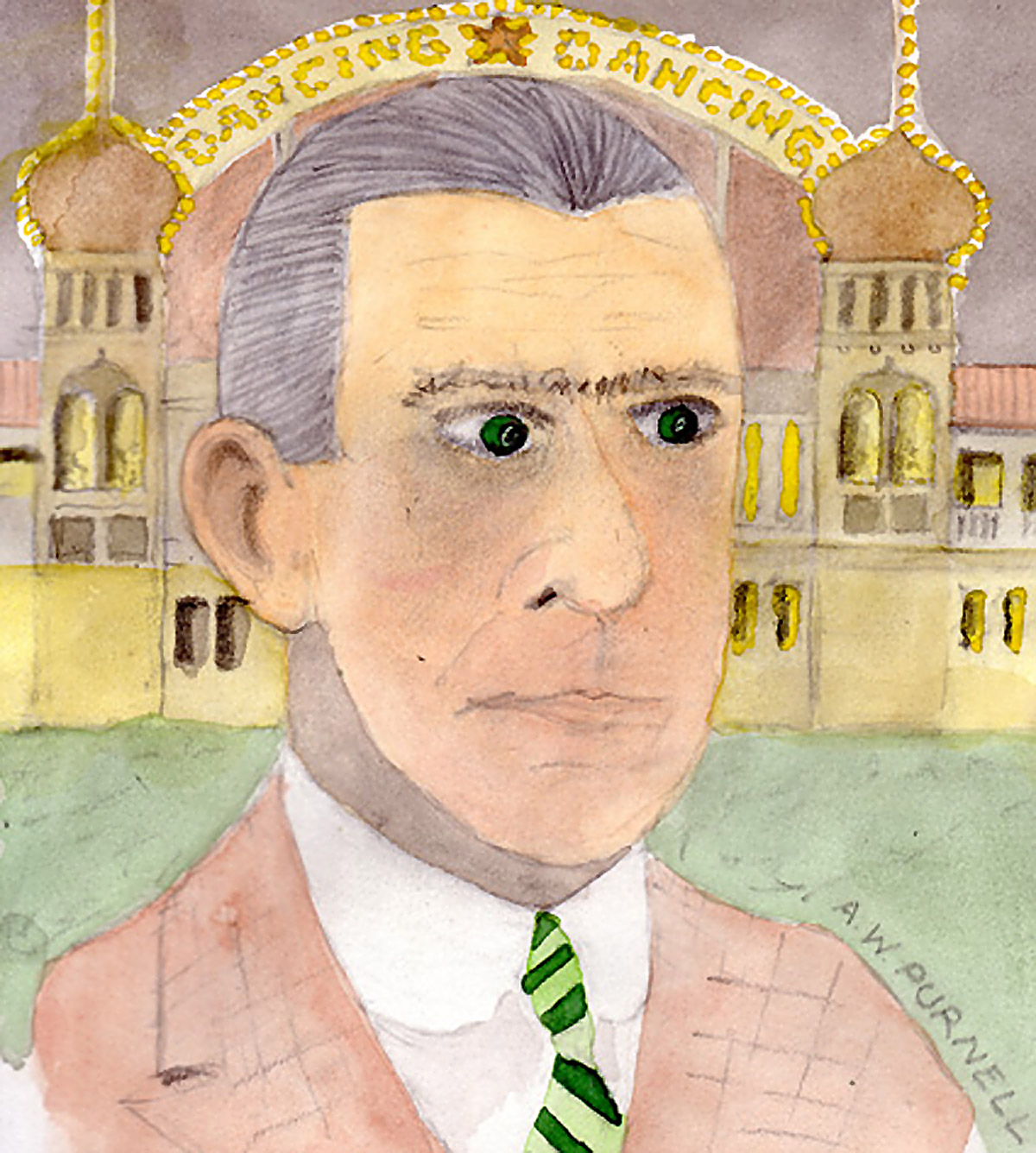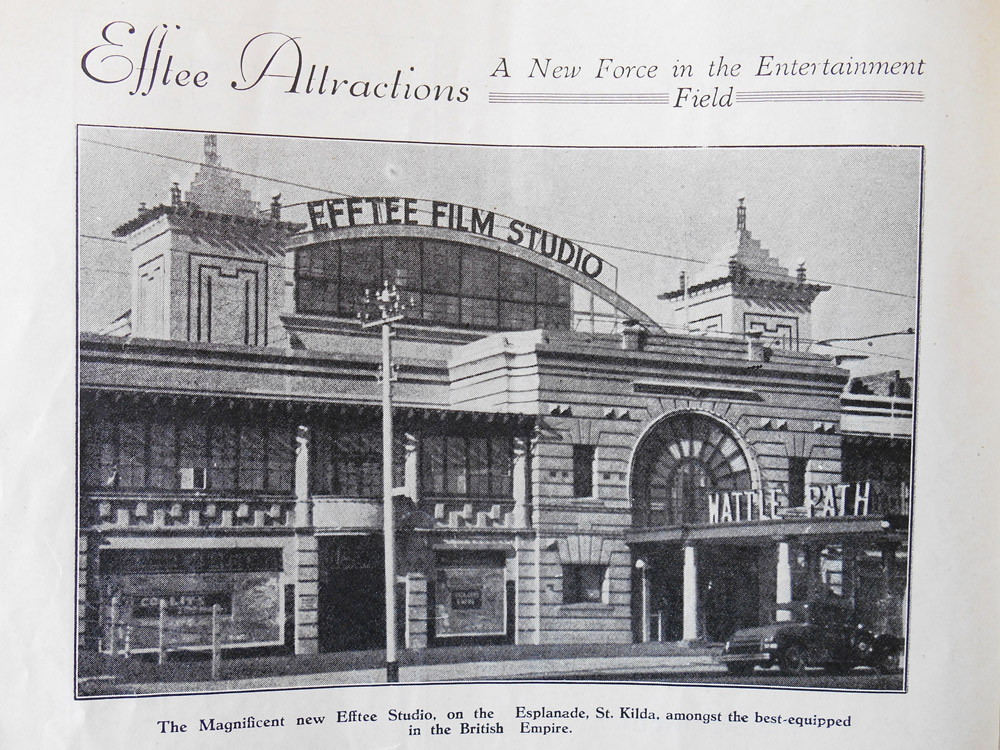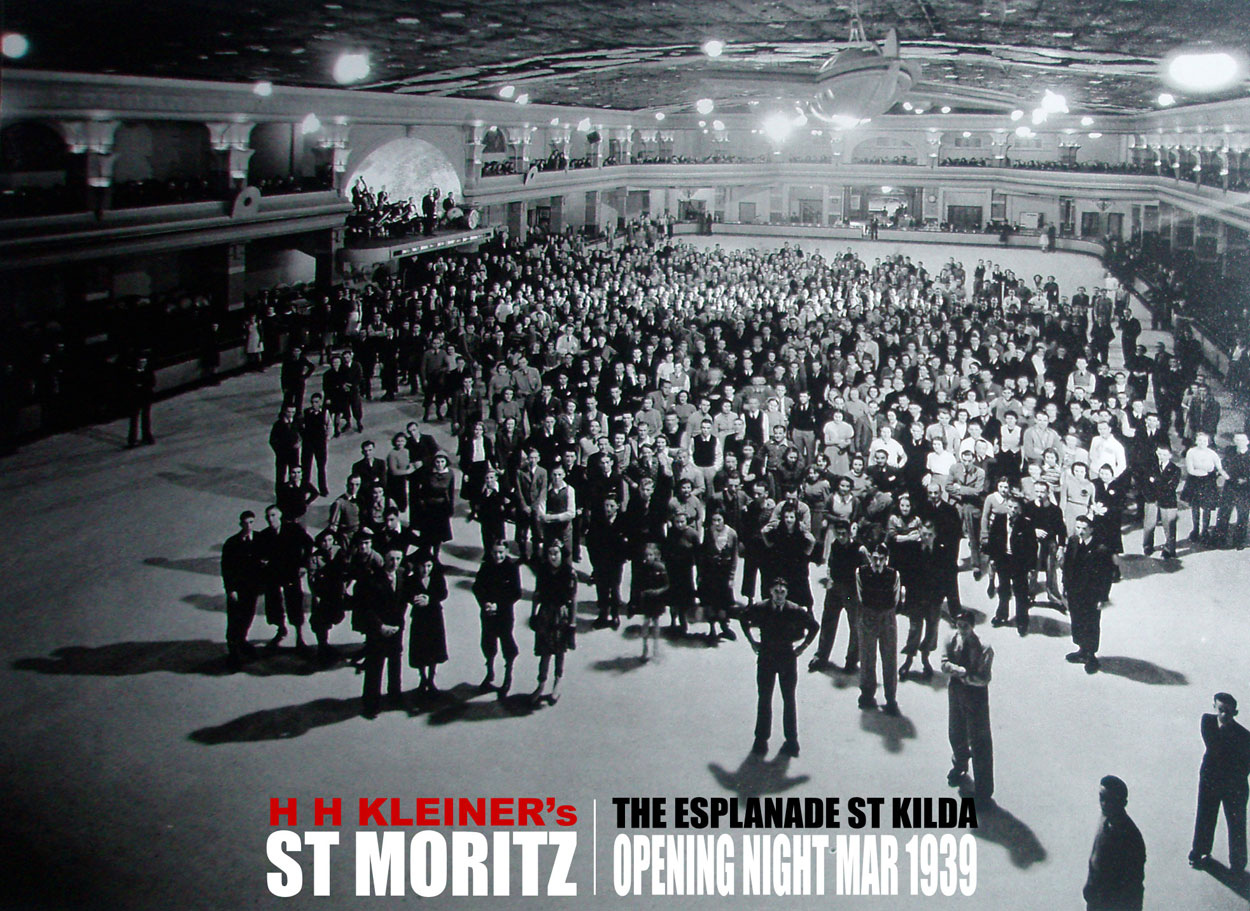
The House that Harry Built
Harry Kleiner and the Skaters of St Moritz
It was Kleiner who introduced the "personality meter" and the "talking scales" to Melbourne some years ago, and made a pot of money with them. It was Kleiner who introduced old time dancing at the Palais Royale, an annexe of the old Exhibition Building, and sold out at a profit of thousands after having made Melbourne polka-conscious, and having introduced the circular waltz to a generation that knew it not. Kleiner has made his pile. He could have retired years ago. But when he hears the band he can't keep out of the ring—just like on old circus horse.
SMITH'S WEEKLY ON MELBOURNE ICE SPORTS ENTREPRENEUR HARRY KLEINER, SYDNEY, AUSTRALIA, 1940.18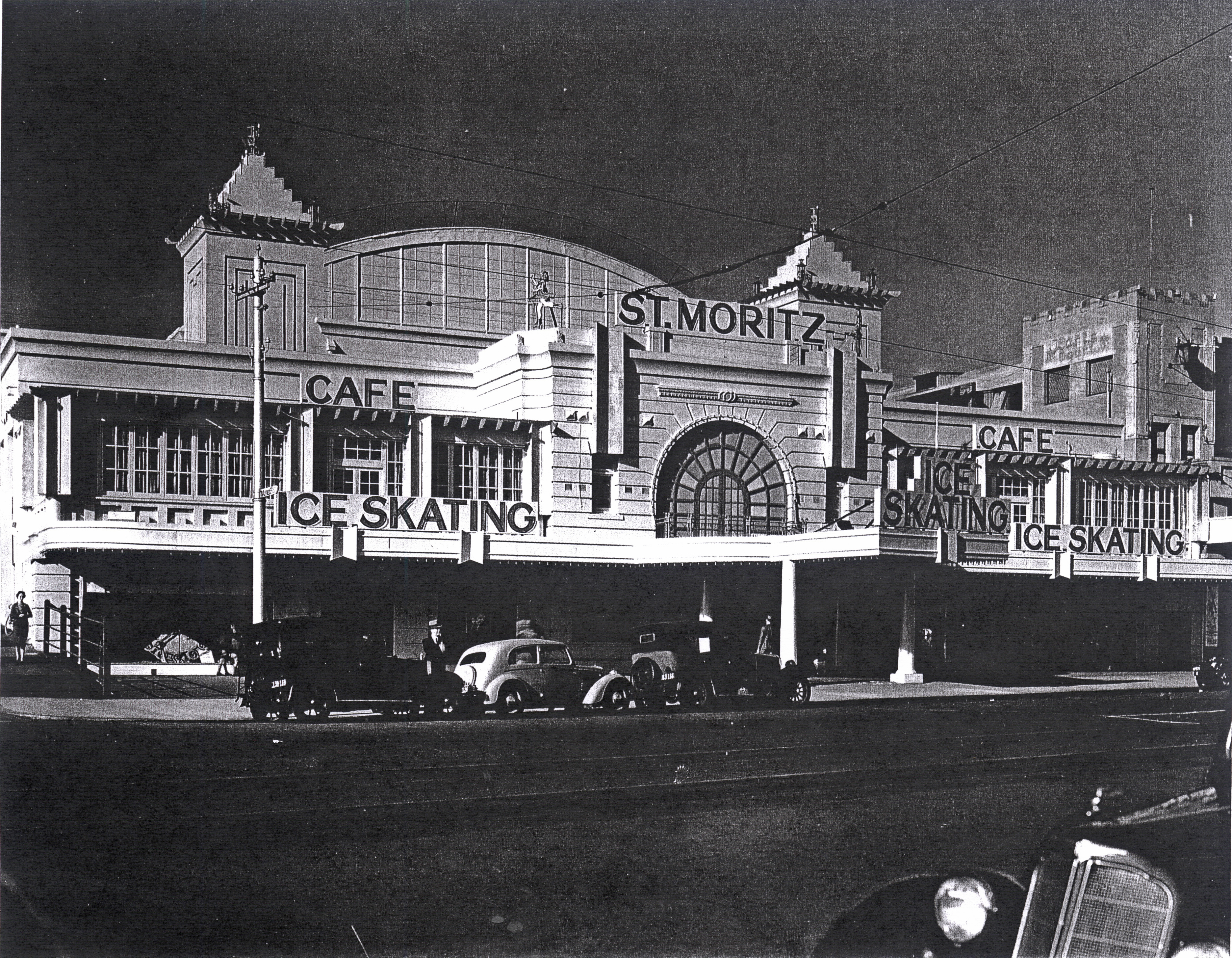
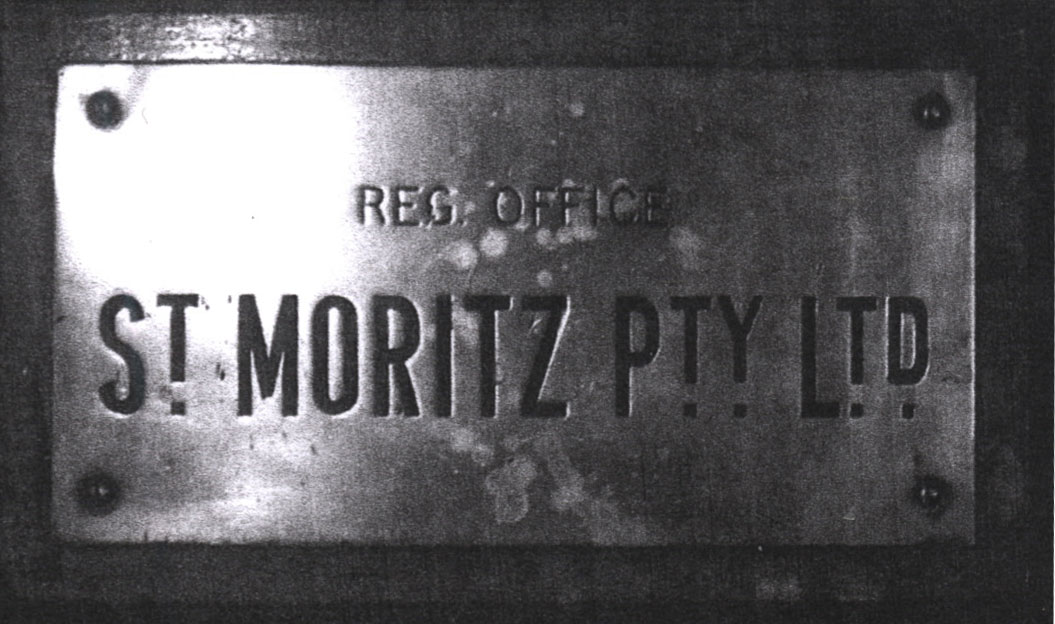 St Moritz Ice Palais The Esplanade St Kilda, Melbourne, 1939.
St Moritz Ice Palais The Esplanade St Kilda, Melbourne, 1939.
THE LADY RIDER looks sensational trotting naked across the Chicago fairground on a steaming white horse like Lady Godiva. With a chink of metal, Sally Rand, the 29-year-old out-of-work silent film actress turned burlesque dancer, bridles in her unauthorised stunt. It wins her star-billing at the Streets of Paris concession on Midway at the 1933 Chicago World's Fair. Those chastened tresses, her long blonde hair, did precious little to protect her honour. One busy day, Sally got arrested for indecent exposure four times. Twice after her fan dance, once riding the white horse down the streets of Chicago with only the illusion of nudity, and once again in Hollywood body paint applied by Max Factor no less. Here at the World's Fair in between countless arrests Miss Rand re-boots a stalled career, most famously with an ostrich-feather fan dance to Debussy's Clair de Lune.
Parts of Prohibition-free Chicago thrive in the dark and gloom of the Great Depression. Like everything else, the theatre scene is Al Capone and mobsters, the mafia and speakeasies. Struggling musicians find solace in blues and jazz clubs, and some even remake a name for themselves. With many unemployed and dependent on food hand-outs to get by, the fair reports twenty-two million paid admissions. Two million are from Streets of Paris, a concession managed by Melbourne showman Harry Kleiner, namesake of the H H Kleiner Trophy of Melbourne ice hockey fame.1
The Midway exhibit is full of nightclubs such as the Old Morocco, where future stars Judy Garland, The Cook Family Singers, and The Andrews Sisters perform. Ice skating stars show off their moves on the frozen mill pond of the Black Forest Village, among them Charlie and Vida Uksila, the professional instructors at the St Moritz Ice Skating Club of San Francisco. The pair coached and skated in both Melbourne and Sydney in 1920 and 1923. The picturesque houses and shops surrounding the frozen pond sell the products of German home industries.
The sign at the entrance to Streets of Paris reads: "Here's where you'll get your real French atmosphere. Cafés, bars, artist quarters, shows, dance plazas, shops, street scenes, free continuous entertainment, champion diving, dancing, music. No cover charge". Inside, faithful reproductions of buildings form thoroughfares named after the streets of Paris. The dancing floor beside the Lido swimming pool bursts into life between four and six in the afternoon and every evening. Fifty dancing girls and entertainers perform the floor show, catwalk parades by Parisian mannequins, diving exhibitions by Olympic champions. Seven "artist studio" entertainments trade against a backdrop of old walls and small cafés from the streets of the Montmartre quarter of old Paris, famous for the Moulin Rouge. Cigarette girls, flower girls and other Parisian characters. A French wine and liqueur exhibit in a bespoke building, Café de la Paix, indoor and outdoor tables, table d'hôte and à la carte service. Orchestra, floor show and dancing for guests complete the effect in the afternoon and evening.2
SOME MONTHS EARLIER, many miles away in Melbourne, Australia, the inquest into the death of Josephine Kleiner heard evidence of domestic differences with husband, Harry. He left their Brighton home at No 302 St Kilda Street for Sydney on September 14th, 1932. Josephine had been in ill-health for five years and threatened to poison herself several times. The city coroner did not allow her letters to be published, but a weekly magazine had done that anyway. The coroner found that Mrs Kleiner committed suicide on September 24th by taking poison.3 Passports registered that year in the names of Harry Kleiner and Nellie Stuart are held by the National Archives. The couple had departed for the opening on May 27th of the Chicago World's Fair billed as "A Century of Progress 1833-1933". They married in 1934.
Born in 1887 in Victoria, Henry Hans Kleiner inherited the varied interests of his Hamburg-born father, a decorator for the German Court, who became supervisor of the decorative work at the Melbourne Exhibition of 1880. The licensee from 1889 of the Sydney Hotel at Wangaratta in rural Victoria, Henry redecorated alright, but he also cultivated a keen interest in many local activities, and acted as marshal for St Patricks and other processions for many years.4 He went on to Chapel Street merchandising while living at Richmond in inner Melbourne. Then he opened the Direct Import Supply Stores in Swanston Street and Bourke street next to the old Tivoli Theatre.
You might then correctly surmise it was in the blood of young Harry to promote buck jumping and vaudeville at the Exhibition Oval in Melbourne in 1928 and dancing at his Palais Royal dance hall in the Exhibition Buildings. He was indeed a career showman who claimed he put The Siamese Twins, the Hilton Girls, Daisy and Violet, on the map when they were only five. He was known for all manner of circus acts and freak shows around the country. You might guess rightly that he was taking the long way home following in the footsteps of his father when he travelled 68,000 miles through America and Europe to inspect national and international fairs and exhibitions in search of ideas for the centenary celebrations of Melbourne. Impressed by the necessity of having an international fair, Harry intended to apply for permission to stage one in the Exhibition grounds during the centenary.
Most Melburnians did not feel they had much to cheer about at the dizzy height of the Great Depression. Vandalism, sly-grog dealing, drug peddling and prostitution were reshaping the seedier side of St Kilda, the seaside playground of the rich, imbuing it with the kind of notoriety that eventually came to define it. The Centenary Peoples Fair named Joyland at Yarra Park late in 1934 had sideshows and entertainments, but only a few thousand revellers attended.6 Kleiner might have had a hand in it, but it was the Streets of Paris at the Wattle Path Palais on The Esplanade in St Kilda that "made full use of his experience as manager of a similar entertainment at the Chicago World's Fair in 1934".5 A large gathering at the opening on Boxing Day 1935 enjoyed the dancing, cabaret turns, games, scenic effects, and the dress of its attendants. The hall had a Continental air. The former theatrical dancer, Phillis Glen, supervised the ballets and the London scenic artist, W R Coleman, painted the scenery at the start of a theatrical career that ran over three decades here and countless productions in every state.5
The building had been the Wattle Path Palais de Danse and Café for a decade since it opened in 1922, designed by architects Beaver and Purnell. The partner Isidor Beaver was a patron of Victorian ice sports. One of the original four ice hockey teams in Australia took his name. The onion domes of early designs were influenced by Islamic architecture, quite unlike the resulting orientalism. Of interest was its design and location in the heart of the St Kilda pleasure precinct and its size and history. It was one of the largest dance halls in the world, built at the height of the dance boom, the record crowd of five thousand jamming themselves in during the visit of the American Fleet. Two famous American bands played there at different times, the Yerkes S S Flotilla Dance Orchestra and Walter Rudolph's Syncopaters. Dancers fondly remembered the Palais hall in which representatives from all States contested the first Australian Championship. The prize money on both nights worked out at more than £50 a minute (about $3,600) and a trip to England.7
In 1930, Kleiner purchased the racehorse Mystic Peak which placed second to Phar Lap in the 1930-1 VATC Futurity Stakes at Caulfield Racecourse in Melbourne. The world famous thoroughbred claimed the title of the highest stakes winner in Australia that year and gave people hope in the Great Depression. Mystic Peak won the 1931 Australia Stakes at Moonee Valley Racecourse in Melbourne.
Meanwhile in Sydney, Kleiner's counterpart, Jimmy Bendrodt, had similar business and sporting interests. While conversion of the Sydney dance hall into the new Ice Palais might have raised an eyebrow with war imminent, the announcement of the construction of an ice skating rink at Wirths Park in Melbourne must have been a red flag to a bull. Entered from St Kilda Road directly opposite Melbourne Glaciarium, Royal Ice Skating Palais proposed the 85.3m x 54.9m rink (280-ft by 180-ft) controlled by Ice Skating Palais Ltd Sydney, and operated by a new company with "a preponderance of Melbourne directors".8
On a visit, Russ Carson, the Canadian minder for Sydney's Ice Palais Bears, had suggested to Kleiner his dance hall by the sea would make a great ice rink. Some weeks later, Kleiner casually announced the preliminary work of converting it into a modern ice skating rink had begun. There was no fanfare, no awards for originality, but Kleiner did have a 15-year lease over the property, and he did intend to float a public company to take over the St Moritz Ice Palais when built. The architects were Cowper Murphy and Appleford and the builder was W. Sinton.20
Not surprisingly, the ice rink proposed by Bendrodt opposite the Glaciarium never proceeded, and war brought St Kilda an influx of sailors. In their wake came the prostitutes, the trannies, artists, freaks and assorted weirdos. Australia's longest-running gay bar began there in 1937, given new impetus over the years by long-running drag nights such as Pokeys at the Prince of Wales and the famous Sydney drag troupe, Les Girls, at the Ritz Hotel. Les Girls was the first official drag performance ever staged in Melbourne in 1970, and its arrival caused a sensation.
THE IMPOSING ST MORITZ FACADE on The Esplanade at St Kilda is designed to represent the very spirit of entertainment. The windows of the new front café command excellent views over the bay above a new cantilevered awning that floats across the whole frontage. Combined with dining room and grill there is seating for four hundred. Planned as a Swiss Alpine hostelry, the interior architecture here repeats in quieter shades of the main auditorium. The mouldings and features of the original dance hall are picked out in bright colour reliefs and custom sodium and neon lighting. A roomy gallery affords a view over the entire rink for spectators, served by a refreshment booth and milk bar. There is a similar service on the ground floor.20
Powered by Bell refrigeration, the ice pad, 57.9 by 24 metres (190 by 79-ft), has a balcony dance floor extending around its interior, a Swedish café, electric and Turkish baths.10 The interior colours are contrasting gold and royal blue. The ceiling is one of the long, unsupported spans in Australia. The beams are coloured to glow as if lit and myriads of lights glisten against the royal blue sky among modernist clouds in panels of low relief. Many of the ten thousand stars are plaster, and the largest contain chloride of lime and act as humidifiers. They absorb the moisture caused by condensation from the ice. The rotating chandelier in the middle incorporates over 6000 mirrors with highly coloured surrounding bands representing the planet Saturn. Large plaster aeroplanes, each driven by an electric motor, are used as interplanetary units to give featured illumination. Shield decorations used as wall panels and chalet type window shutters add to the Swiss chalet effect.20
Bright coloured furniture harmonises with the exotic colour schemes, providing seating for one thousand in the mezzanine observation area. The area immediately behind the elevated orchestral stage is a vice-regal box. The stage itself is designed to present a special silhouette and has an Aurora Australis lighting effect flowing across the acoustically planned background. Hydronic (steam) heating extends throughout the building and into the café and milk bar.
More than one thousand skaters throng the new St Moritz Ice Skating Palais on March 10th 1939, when it is officially opened by the Mayor of St Kilda, the president in waiting for St Kilda Football Club. Canadian experts give skating exhibitions: Gladys Beauregard, Ed Ruska, and Australian skaters Betty Cornwell, Edith Adams and Jim Paxton.11 Skaters dance or promenade the rink to the music of the Harry Jacobs Band. Jacobs is married to the renowned ballerina Madame Lucie Saranova. Their 18-year-old daughter, Wendy Lee (Jacobs), is one of the featured skaters. She will produce regular ice ballet shows here for over a decade, including Icecoppelia (1948). Like Anna Pavlova, Madame Saranova was a pupil of Enrico Cecchetti. She now heads a faculty at the National Theatre Ballet School here in St Kilda that offers the Cecchetti Syllabus. The singer and radio personality, Kathleen Goodall, the wife of John Goodall of national ice hockey fame, can thank the National Theatre headed by Gertrude Johnson for her early stage experience.
"Another ice skating rink has been born," announced the Referee newspaper in Sydney. "The St Moritz Ice Palais and the Melbourne Glaciarium are linked-up with the Australian Amateur Ice Hockey Association. It is possible that Sydney will have a third rink in the near future. At this juncture details cannot be announced. It is possible a rink may be built at Orange." Well, that did not happen, but the article speculated that "the NSW association will probably have two referees in action for their matches this year instead of one. That is a step in the right direction". Jimmy Bendrodt's simple request the year before was fulfilled, at last. It confirmed the breakaway association and ridiculous player suspensions were nothing more than an official disaster that had been entirely avoidable.
After the controversial tour of the Canadian Bears ice hockey team, the state association in Sydney negotiated with Bendrodt to have the ice hockey at the Ice Palais under their banner again.15 Examinations for referees began while "the association was seeking neutral offices; in other words, it does not want its headquarters to be at any rink, now that there are two rinks in Sydney. The neutral layout would be in the best interests of the game".12 The association admitted "great strides were made last year," and they learned from the Canadian Bears visit, particularly the need for player teamwork and combination. There was even a discussion of developing a team for the next Olympics.15 Ted Molony, president of the Victorian association, said: "ice hockey in Victoria had received its greatest lift since the game was introduced. The association had been handicapped in trying to build up public support as it was very hard getting people interested in watching the same teams playing at the same rink each night. Attendance at the association's AGM was fully 300 per cent greater than the previous year."16
That year in Melbourne, the new St Moritz Bombers battled the new Glaciarium Rangers and Foy's Gibsonian Flyers. The following year, they were joined by Russ Carson's Rhodes Topliners until after the war when all four morphed into the Red Arrows, Tigers, Demons and Monarchs clubs, two of which still survive. As if to celebrate, St Kilda set the pace for Melbourne's 1939 New Year celebrations. More than 150,000 people witnessed the fireworks display on the waterfront when £300 went up in smoke (about $23,000). Luna Park opened its doors at midnight. The St Moritz ice carnival began at midnight with a floor show and skating until dawn. The Palais de Danse Gala New Year's Eve party also began at midnight. The Palais Pictures opened its doors at 11:30 pm, and the picture programme started shortly after midnight. There were massed band performances, and all the other sideshows opened at midnight and continued until daylight.14
During the war, the proceeds of St Moritz events and galas went to various charities, and the philanthropy continued after the war. For instance, Kleiner presented £529 or about $31,000—the proceeds of the St Moritz ice carnival on Melbourne Cup night—to the Lord Mayor's Olympic Games appeal in 1947.17
THE ICE HOCKEY CLUB that grew up around the sailing masts and sea baths at St Kilda might seem out-of-place in the suburb once favoured by Melbourne's élite. But most palatial mansions constructed along its hills and waterfront had long been turned to other uses. With the opening of Luna Park in 1912, the foreshore became Melbourne's amusement zone, then the city's red light district, its bohemian style and cheap housing attracting young artists and musicians after the second world war.
St Kilda also attracted sporting champions, which was business as usual at many of Australia's iconic beaches. Manly and Bondi in Sydney had ice rinks around this time and, by 1949 in Melbourne, ice sport was as much a part of its seaside Coney Island or Brighton as sailing. Two clubs ruled the Bay before merging to become the Royal Melbourne Yacht Squadron. The 14-ft sailing club produced Pirates hockey, its red flag with yellow cross and "S.K.14F.S.C" emblazoned on a black jersey long before the ominous skull and crossbones struck fear into the hearts of hapless landlubbers on the higher ground above the palm-lined promenade.
Bill Normoyle managed The Esplanade ice rink with a very firm hand for Harry Kleiner in those balmy days when entry cost 11-pence, and the Red Arrows, Monarchs, Demons and Tigers plotted with the Pirates to bring down the Glaciarium clubs. Lindsay Fox, the strapping, six-foot defender of Linfox fame; former state diving champion Johnny Nicholas; and his mate, Roddy Husten, the Pirates first-liner before joining the Demons. Howard Reede-Pulling once described Husten as a diminutive little fireball of energy. Others who lived or worked nearby included players Kevin Gronow and Brian Bullen and Olympic speed skater Colin Coates.
Pirates' goalie Clarrie King was Russ Carson's protégé, a good thing for King given the Canadian ex-pat was the best to ever play in Australia. Those present rated King's performance in a breakaway VIHL league team against NSW in 1949 as "the best exhibition of netminding they had ever seen". By 1956, the year of Australia's failed Olympic ice hockey bid, most good judges considered King the best Australian-born goalkeeper they had seen. He saved 88 per cent of shots in the four-and-a-half Pirates seasons for which there are stats.
St Kilda has always been a place of grand design, from palatial mansions to Catani's foreshore, from botanical gardens to pleasure precincts. The grand design of Molony and Gordon included the takeover of St Moritz in 1952 and the introduction of Saturday night dances showcasing the skills of many notable soloists such as Nita Solomon, Pat Weedon, Jacqueline Mason, Tim Spencer, and his sisters Faye and Shirley. Pat Longden who married ice hockey player Graham Argue became a professional instructor there in 1949. The couple opened an ice rink at Oakleigh in 1971 which was still running in 2021. Former World Professional Pair Champion, Carie Richardson, learned to skate from Jack Gordon at St Moritz.
King's protégé, Peter Cavanagh, learned his stuff in the B-grade while standing in for the seniors and DJ-ing for 3AK and 3KZ. He then represented Australia in the net for every game of the 1962 Worlds after the IIHF ruled the first-string goalie ineligible. Cavanagh was the minder of Australia's first international victory.
But old Pirate Clarrie, the best local in ice hockey, left the net permanently after just 60-odd encounters and one difference of opinion. He played defence at home instead, accumulating a combined total of 230 games. Russ Carson moved to St Moritz from Sydney in 1939. Otherwise, King and Cavanagh may not have become the goaltenders they did, also unlikely Australian ice hockey would have ever gone to the Olympics. Carson's direct line of successors passed down his skills at St Moritz for over 20 years, until their arrival on the ice hockey world stage during the early Sixties. King became Lord Mayor of the city by the Bay that had so occupied his heart.
BY 1946, SYDNEY SKATERS Pat Gregory and Margaret MacDonald taught skating at St Moritz, and Sydney ice hockey player Percy Wendt coached there. Wendt was the top point scorer in the first half-century of Australian ice hockey. St Moritz management fostered junior hockey programs and interstate tournaments, and began national ice racing. The VIHL formed in 1948, and by 1949 there were nine ice hockey clubs in Melbourne, an all-time peak. St Moritz was well on its way to becoming one of the most popular social hubs of St Kilda and Melbourne. It is still fondly remembered by thousands of visitors and residents who arrived on the Esplanade to be greeted by the two glowing neon skating girls flanking the St Moritz sign, two-and-a-half floors above the pavement.
Looking outward, Kleiner formed a partnership with theatre-owners Sir Thomas Coombe and Sir Benjamin Fuller to build a rink in the old Electric Supply Company building at the corner of Grenfell Street and East Terrace in Adelaide. It was to seat 2,500 with an international-size ice pad, but it did not proceed even though Kleiner had purchased the land. Fuller instead developed the first ice rink in Perth, which opened in 1950, by converting the Tivoli Theatre on the St Moritz model.
Harry Kleiner owned the rink complex until two years before his death at Brighton in Melbourne in 1959. There were no more Lady Godivas, just a brave new era of Victorian ice sports, culminating in Australia's participation in Olympic ice hockey. He was 72, survived by his second wife Nellie (formerly Curnow aka Stewart), and a daughter also named Nellie. His second wife was the mother of ice hockey player Alwyn Stewart from her first marriage. She died in Brighton in Melbourne in 1975. Alwyn Stewart managed St Moritz in the 1940s and '50s. A perfect gentleman, players gave him the best games fans had ever seen which, in turn, produced the best conditions players ever had. The Kleiner Cup is still awarded annually to the State champions of senior ice hockey in Victoria. It had been called the Sutherland Cup since at least 1923, the year the first National ice hockey association formed.
The Ice Palais in both Sydney and Melbourne were the second ice rinks to be developed in their respective States after the Reid Glaciaria. Both developers marketed their rinks aggressively from the late 1930s, importing professional British and Canadian coaches and players to help develop and promote local ice sports talent, much like the Reids had done during the foundation years. St Moritz itself survived as the flagship ice arena in Melbourne for over four decades, and dozens of rinks followed throughout all Australian states.
Former Victorian ice hockey Olympian and flag bearer, Vic Ekberg, was rink manager when St Moritz closed in 1982. "I'm not interested in hypocrites," he said. "Hypocrites are people who come around saying how sorry they are the old girl is on her death bed. If people wanted to come why didn't they come during the past nine months. Hypocritical, that's what it is. Let the old girl die in peace". Just one skater came in on the last night. Ekberg was president of the state ice hockey association, and Lindsay Fox let him have St Moritz for one dollar a year rent.21
Frank Thring's dad had planned a Hollywood there, but on the eve of another world war Bendrodt and Kleiner re-created a prosperous marketplace for new ice rinks thirty years or so after ice sports began in Australia. They raised the bar in the process, exploring the best the world had to offer and bringing it back home.
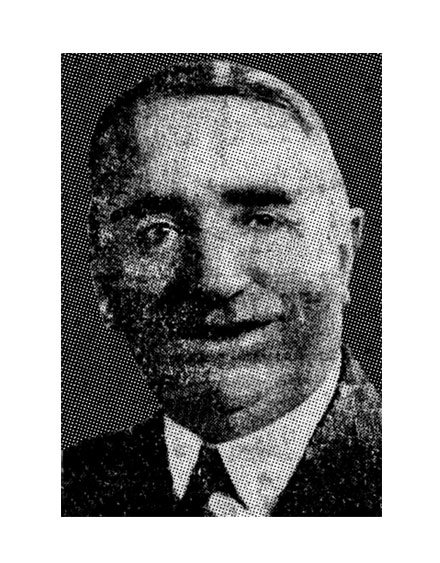 H H Kleiner developer-operator, St Moritz Ice Palais, St Kilda, Melbourne.18
H H Kleiner developer-operator, St Moritz Ice Palais, St Kilda, Melbourne.18
[1] The Argus Melbourne Tuesday 8 May 1934 p 8. Fair In Exhibition. Ideas From Overseas
[2] The Official Guide Book of A Century of Progress Exposition Chicago, Streets of Paris, 1933
[3] The Argus Melbourne, 5 Oct 1932 p 9. Letters Witheld at Inquest
[4] The Corowa Chronicle NSW 6 June 1925 p 3. Obituary
[5] The Argus Melbourne, 27 Dec 1935 p 8.
[6] The Argus Melbourne, 27 Sep 1934 p 13. Opening of Joyland
[7] Table Talk Thursday 29 Jun 1933 p 5 Famous Dance Hall as Studio
[8] The Argus Melbourne 5 Sep 1938 p6
[9] Referee Sydney, NSW 16 Mar 1939 p 23. Ice Hockey Rinks Springing Up. Two IHA Referees At Each Match
[10] The Argus Melbourne 26 Nov 1938 p 10. St Kilda Ice Rink
[11] The Argus Melbourne 11 Mar 1939 p 31 Ice-skating Rink
[12] Referee, Sydney, NSW 16 March 1939 p 23. Ice Hockey Rinks Springing Up. Two IHA Referees At Each Match
[13] Williamstown Chronicle, Vic, 17 August 1940 p 5. Spills Ahead by KEM.
[14] The Argus Melbourne 30 December 1939 p 11. St Kilda Programme
[15] Referee 9 Mar 1939 p 21. Team Likely To Be Sent To Next Olympics
[16] Referee 11 May 1939 23. Victoria Boosted By New Rink
[17] The Argus Melbourne 5 Dec 1947 p 21. £529 for Olympic Fund
[18] Melbourne Man Put Siamese Twins on the Map. Harry Kleiner Tells of his career as a showman. Smith's Weekly, Sydney 30 May 1940.
[19] Nellie (Curnow) Kleiner (1894 - 1975), Wikitree. Online
[20] St Moritz Cafe and Skating Rink Form New Entertainment Centre, Decoration and Glass, May 1939.
[21] The Old Girl Goes Quietly by Michael Wilkinson. Unidentified newspaper, Melbourne, 1982.
[22] The Argus newspaper, Melbourne, May 8th 1934.


